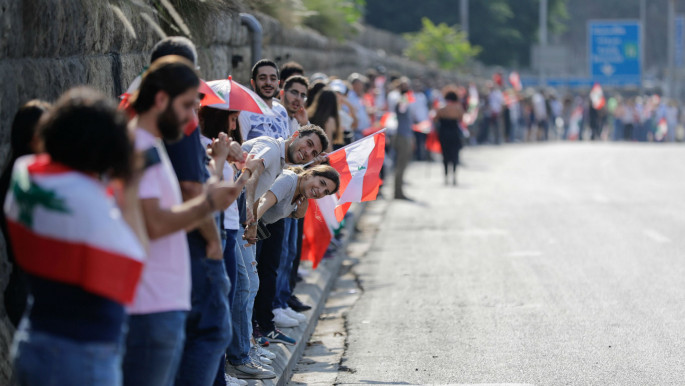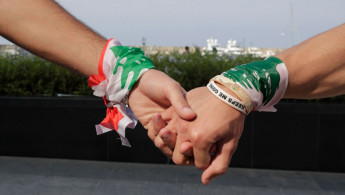Lebanon protesters successfully form north-south human chain in spectacular show of national unity
Demonstrators joined hands from Tripoli to Tyre, a 170-kilometre (105-mile) chain running through the main protest hub in Beirut, as part of an unprecedented cross-sectarian mobilisation.
Tension has mounted in recent days between security forces and protesters, who have blocked roads and brought the country to a standstill to press their demands for a complete overhaul of the political system.
Lebanon's reviled political elite has defended a belated package of economic reforms and appeared willing to reshuffle the government, but protesters who have stayed on the streets since October 17 want more.
On foot, by bicycle and on motorbikes, demonstrators and volunteers fanned out along the main north-south highway.
"I can confirm that the human chain was a success," Julie Tegho Bou Nassif, one of the organisers, told AFP.
"Everything is ready, we even have volunteers on motorbikes who are helping us identify gaps in the chain," she said.
|
||
The idea behind this human chain is to show an image of a Lebanon which, from north to south, rejects any sectarian affiliation," the 31-year-old history professor told AFP.
"There is no political demand today, we only want to send a message by simply holding hands under the Lebanese flag."
'United'
On the Beirut seafront, men, women and children held hands, some carrying Lebanese flags and many singing the national anthem, an AFP photographer said.
"The idea is that from the north to the south we are united and making a stand together," said another organiser in Zeituna Bay, who asked to be called a "daughter of Beirut".
"We are one people and we love each other," she told AFP, in between coordinating on one of her two mobile phones.
On the main highway northeast of Beirut, another AFP photographer saw dozens standing along a stretch of highway under a rocky hillside covered in bushes.
In the southern city of Tyre, protesters standing in a line held the edges of a long Lebanese flag, local television showed. A young boy played with it, making it billow up and down.
The protests have been remarkable for their territorial reach and the absence of political or sectarian banners, in a country often defined by its divisions.
The leaderless protest movement, driven mostly by a young generation of men and women born after the 1975-1990 civil war, has even been described by some as the birth of a Lebanese civic identity.
The army has sought to re-open main roads across the country, where schools and banks have been closed for more than a week.
 |
| The human chain ran the length of the country from north to south [Getty] |
In one of the most serious incidents, the army opened fire on Friday to confront a group of protesters blocking a road in Tripoli, wounding at least six people.
But the unprecedented protest movement has been relatively incident-free, despite tensions with the armed forces and attempts by party loyalists to stage counter-demonstrations.
Protesters have been demanding the removal of the entire ruling class, which has remained largely unchanged in three decades.
Many of the political heavyweights are former warlords seen as representing little beyond their own sectarian or geographical community.
Follow us on Twitter and Instagram to stay connected





 Follow the Middle East's top stories in English at The New Arab on Google News
Follow the Middle East's top stories in English at The New Arab on Google News
![Israeli forces ordered bombed Gaza's Jabalia, ordering residents to leave [Getty]](/sites/default/files/styles/image_330x185/public/2176418030.jpeg?h=a5f2f23a&itok=_YGZaP1z)

